… If WE all just reminisce, on lives passed and lives that exist.
Then let us live in bliss along with the colors that consist.
Something More if There’s Hope.
Let us all have S.M.I.T. H. …
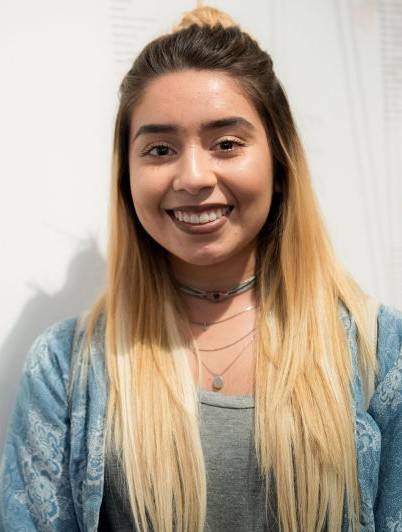
The stanza is from California State University, Dominguez Hills (CSUDH) music student Monica Parra’s poem S.M.I.T.H., which is currently on display in “Watts Now: a Student Exhibit,” an interdisciplinary exhibition featuring 130 works of art, poetry, motion graphics, design info graphics and environmental justice projects that explores Watts 50 years after the Watts Rebellion. The exhibit is on display Feb. 16 – May 12 in the University Library Cultural Art Center.
Parra was chosen to read her poem during the opening reception of the exhibit from approximately 50 other student poems on display in the art center.
“S.M.I.T.H. is an acronym for ‘Something More If There’s Hope,’ and is really about identifying yourself and not letting someone else identify you,” said Parra. “It’s about hope and the culture that exists to ground people, or to help them avoid being crushed by someone else’s views. It’s about being happy with who you are.”
The exhibit is part of CSUDH’s yearlong anniversary commemoration of the 1965 Watts Rebellion, is running concurrently in the art center with the “Watts Then” exhibit, which features selections of archival materials on the Watts Rebellion from Archives and Special Collections in the University Library.
Curated by Michele Bury, professor of Art and Design; Ellie Zenhari, assistant professor of Art and Design; and Kathy Zimmerer, director of the University Art Gallery, the “Watts Now” exhibit is presented by the CSUDH Office of the President and the College of Arts and Humanities.
The majority of students exhibiting in “Watts Now” are freshmen or recent transfer students, according to Zimmerer, and some are new to their chosen art forms.
“In the exhibit, the students have brought and addressed all kinds of perspectives through their art: the ugliness, the beauty of the Watts Towers, the power of politics, as well as problems regarding police brutality during the initial riots and the 1992 riots [in Los Angeles], which one can see in the motion graphics pieces,” said Zimmerer. “We also see the students addressing the environmental justice issues in Watts that the community is still dealing with today.”
“Watts Now”
University Library Cultural Art Center through May 12, 2016,
Monday-Thursday from 10 a.m. to 4 p.m.
For more information call (310) 243-3895.
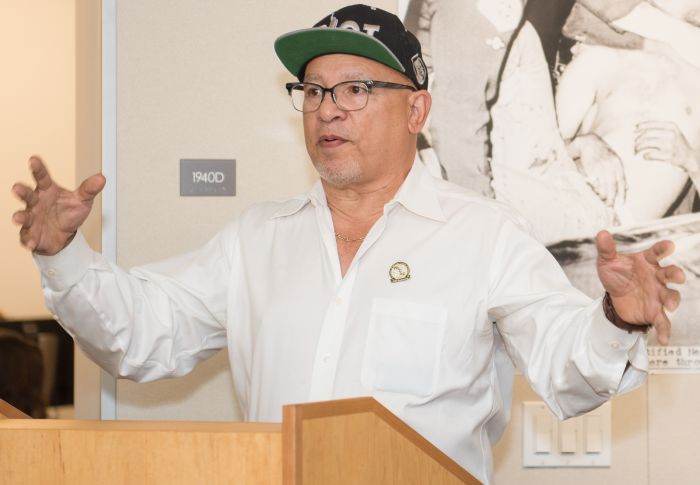
The exhibit’s opening reception, which was sponsored by the Multicultural Center, also included remarks from Tim Watkins, president and CEO of the Watts Labor Community Action Committee, president and CEO of the Greater Watts Development Corporation, and founder of the Greater Watts Transportation Corporation. He also founded and co-chairs the Watts Public Policy Institute and the Watts Renaissance Project, a community-based coalition of grass-root organizations and individuals dedicated to responsible planning and development in Watts.
“The fortuitous audacity of our right to intellectually riot is something that I believe we all deserve to embrace. Ms. Parra’s poem spoke to that eloquently, and that’s what we’re talking about–challenging status quo. We’re not talking about bringing down cities; we’re really talking about exercising our right to stand up, speak truth with power, and voice our objection to the status quo, which continues to see us mowed down,” said Watkins. “Whether it’s law enforcement tactics, the economic strategies that seek to displace us from our communities of tradition, or environmental justice issues that poison us in our sleep, it’s there in the exhibit, and it helps us to understand what we’ve been through.”
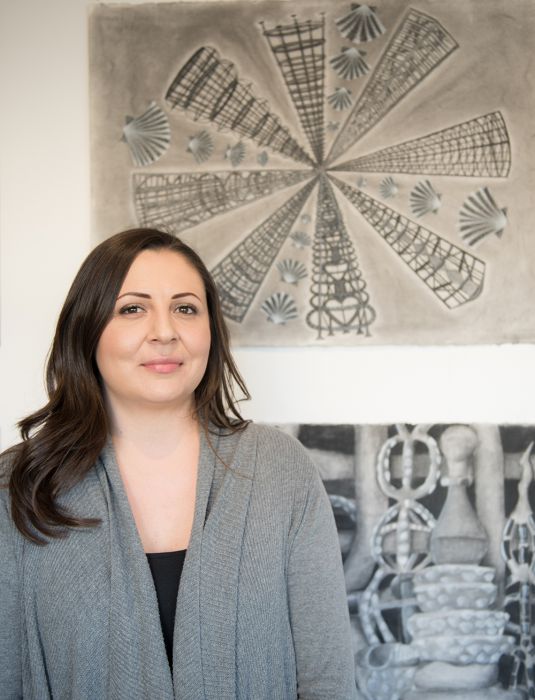
Shawnna Hernandez, a liberal studies student with a minor in studio arts at CSUDH, used compressed charcoal on Lenox paper to create an abstract image of the Watts Towers. To find inspiration for her piece, she visited the towers, then walked around to find a good spot to sit and sketch.
“My piece is the Watts Towers deconstructed and then reconstructed,” said Hernandez. “I like the repetitiveness of the towers, but I wanted to create something a bit more abstract and less of an exact representation of the towers, because I knew many other students were going to do something more closely resembling them.”
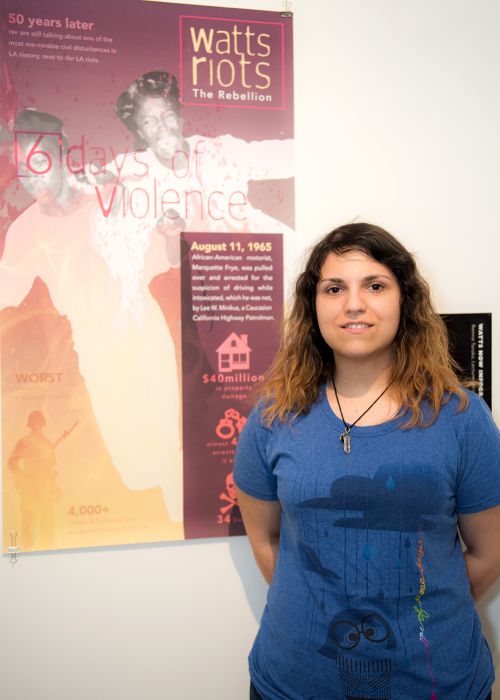
Erika Reynoza, who is majoring in graphic design and studio art at CSUDH, created a poster for the exhibit that reflects the violence of the Watts Rebellion. She also added Toro colors to the piece to represent both changes to the university as a consequence of the uprising, and the fires that destroyed much of the community.
“I wanted it to look very powerful from a distance. I like to work with imagery, so I wanted a very strong piece,” said Reynoza.
Gilah Yelin Hirsch, professor of art at CSUDH, attended the opening reception to check out all the students’ work, and to support her students who were exhibiting in the gallery.
“I lived through the Watts Riots, but for the students, it’s a history that is more legendary, if anything,” said Hirsch. “It is important to keep that legend alive, and to continue to feel the pain of it, even in a remote way, so we know how far we’ve come. If we don’t remember it, we take freedom for granted instead of knowing how hard it is to win.”
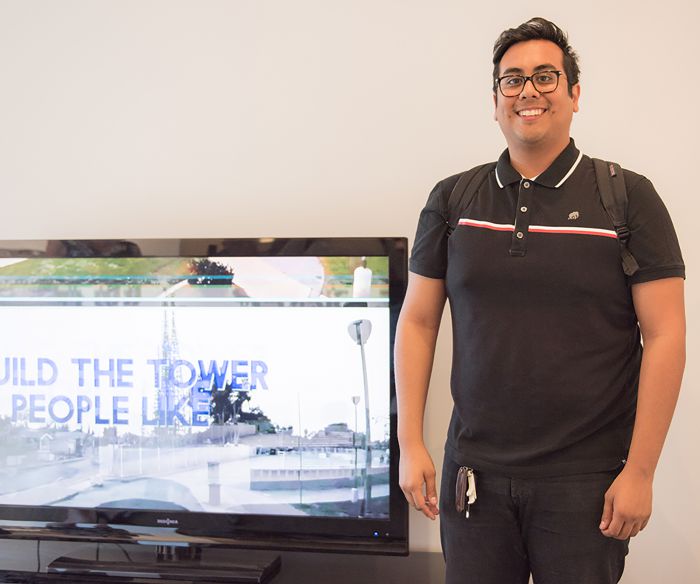
Graphic design student David Peralez created one of the motion graphics pieces, which runs on a loop on a large television monitor with several other 40- to 50-second video clips. He combined photographs with text, circles and other design elements that fade in and out of the video to create a dramatic effect.
“The Watts Rebellion is a very serious subject, and a lot of students created art based on that,” he said. “However, I did it on the Watts Towers because it is artistic and a little less serious–even a little lighthearted. I had a lot of fun with it.”
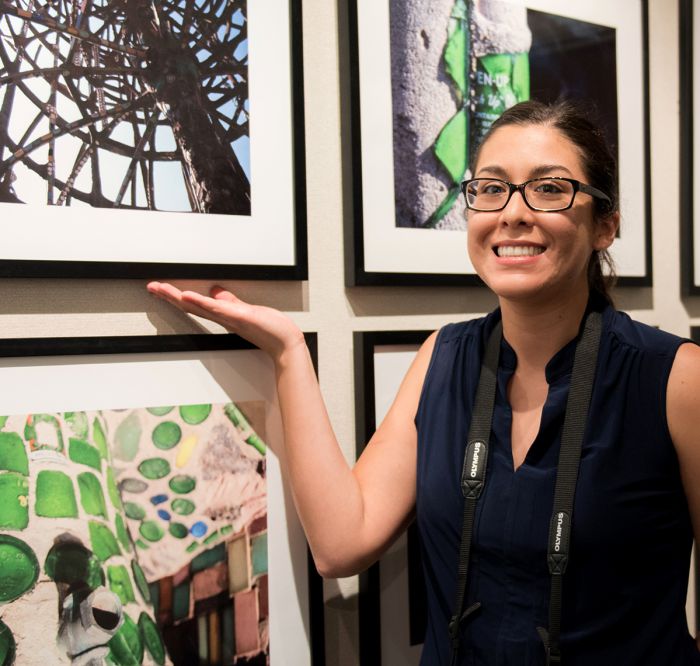
Andrea Rea, a design major and photography minor, was also inspired by the Watts Towers, particularly the amount of time and work Sabato Rodia, the artist who created the towers, put into them, and how “welcoming” sections of it felt to her.
“I like this piece [metal structure of the towers] and all the summary lines going on. It felt welcoming and it drew me in, and I really wanted to capture that,” said Rea. “It was my first time ever in Watts and being close to the towers. I like the mosaics–so many little pieces of glass that were placed there throughout decades. It’s beautiful, and just remarkable.”